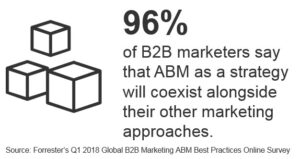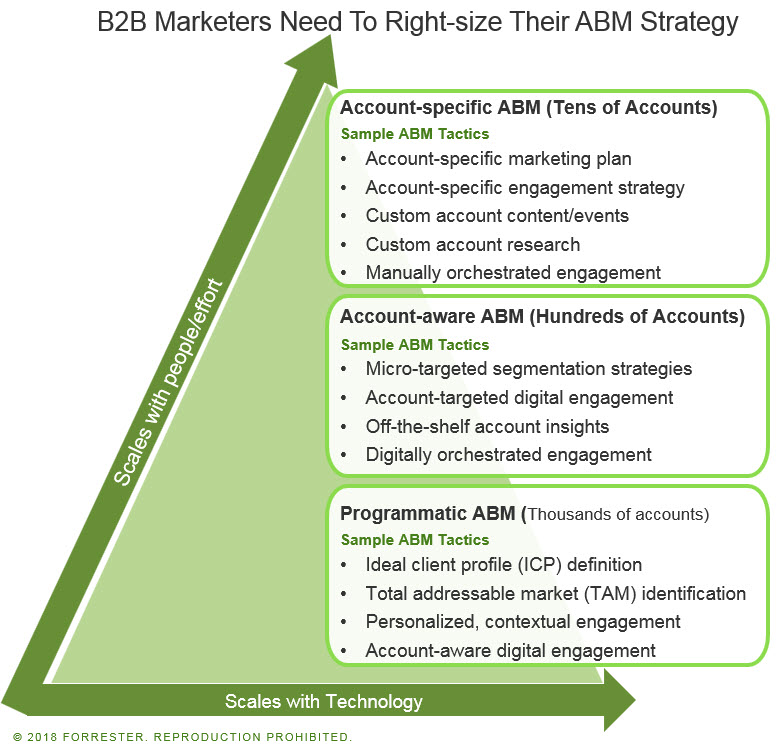It’s Time To Mainstream ABM
When account-based marketing (ABM) burst onto the scene in 2015, it was positioned by a number of vendors as the death of traditional marketing. And while that controversial approach might have been great for creating buzz and drawing attention, it created significant confusion for the mainstream B2B marketer. It’s taken a couple of years to separate the hype from the reality.
Forrester research shows that ABM crossed the threshold into widespread practice in 2017, with about 60% of practitioners telling us they had established ABM programs and approximately 40% saying that they were experimenting with ABM.[i]

But there is still this impression that ABM is something unique, separate, apart. Ninety-six percent of surveyed marketers see ABM as a separate strategy that will coexist with other marketing approaches. Thirty-two percent of companies said they have a senior team member specifically leading the ABM charge, and more than half have a separate ABM budget.
This ABM apartheid means that we’ve not really seen the full impact of ABM theory and practice on B2B marketing.
In October 2016, I made the call that account-based marketing would elevate, not eclipse, lead-to-revenue management. It’s taken a while, but now is the time for B2B marketers to broadly adopt the philosophies, strategies, technologies, and tactics that are bundled under the ABM mantle, because once you strip away the mystique, ABM is really just good marketing. Forrester believes that ABM succeeds when:
Marketing and sales jointly obsess over how to pursue, establish, and grow long-term, highly engaged revenue relationships with specific customer accounts.
It is a mindset focused on quality over quantity and collaboration over silos. And why would you ever choose to operate any other way?
If you decompose ABM into a portfolio of its use cases, you find a better marketing practice that can impact all your marketing efforts and should not be isolated to a subsegment of accounts that are in an account-based marketing program:
- Analytics and burgeoning third-party data sources transform loose segmentation into tightly defined ideal client profiles (ICPs). We commonly see marketers who have refined their targeted segments from tens of thousands of companies to a couple of thousand companies.
- Marketers focused on landing net new accounts can leverage the robust capabilities that some ABM vendors provide for look-alike modeling, account discovery, and contact identification.
- Marketers who focus on account expansion can benefit from the ABM solutions that identify early signals of buying intent.
- ABM technologies for insight-driven, contextualized, and personalized engagement — across a number of digital channels — help marketers create compelling digital engagement throughout a lengthy purchase cycle.

It’s important that B2B marketers understand the breadth and range of capabilities that are brought to market under the ABM umbrella. Every B2B marketer should read “The Forrester New Wave™: ABM Platforms, Q2 2018,” researched and written by my colleague, Steve Casey.
But you might not need to adopt a totally new ABM platform to adopt ABM practices. In the Forrester report, “Predictions 2019: B2B Marketing And Sales,” we predicted that one-third of marketers will build ABM programs on their existing marketing automation platform (MAP) in 2019.
That wasn’t possible a few years ago. The ABM platform vendors were able to create a software category because the mainstream MAP vendors — such as Eloqua, Marketo, and Pardot — had ignored some very important B2B marketing realities (e.g., that B2B purchases are made by teams) and left some very important marketing use cases unaccounted for. These vendors came into existence to fill a gap between lead gen activities — such as email campaigns and trade shows — and the CRM system. They were designed, originally, for drip marketing on steroids. As they developed, the vendors invested in making it easier to develop more sophisticated outbound campaigns and manage funnel marketing — strategies that have been rendered inadequate by the digitally active, self-service business consumer. In short, MAP vendors fell behind on the requirements for marketing best practices.
But the innovation of the ABM platform vendors was a wake-up call. And the MAP vendors rapidly filled — and are continuing to fill — their legacy gaps. They have added account awareness, lead-to-account mapping, and account-based lead scoring. And the more aggressive road maps are adding the analytics to define an ICP, data integrations to identify total addressable market (TAM), and AI to optimize midcycle engagement. So with the rapid evolutionary catch-up, MAP vendors are providing a good platform to take ABM mainstream for many B2B marketers.
I urge every marketer to evaluate the learning, the insight, and the tactics that the ABM movement produced for all of your marketing efforts. Rather than replacing conventional processes and technologies, ABM augments traditional demand generation and account engagement with insights, personalization, and orchestration tools that help both marketing and sales leverage account-specific knowledge to deliver customer-obsessed experiences.
[i] Source: Forrester’s Q1 2018 Global B2B Marketing ABM Best Practices Online Survey
